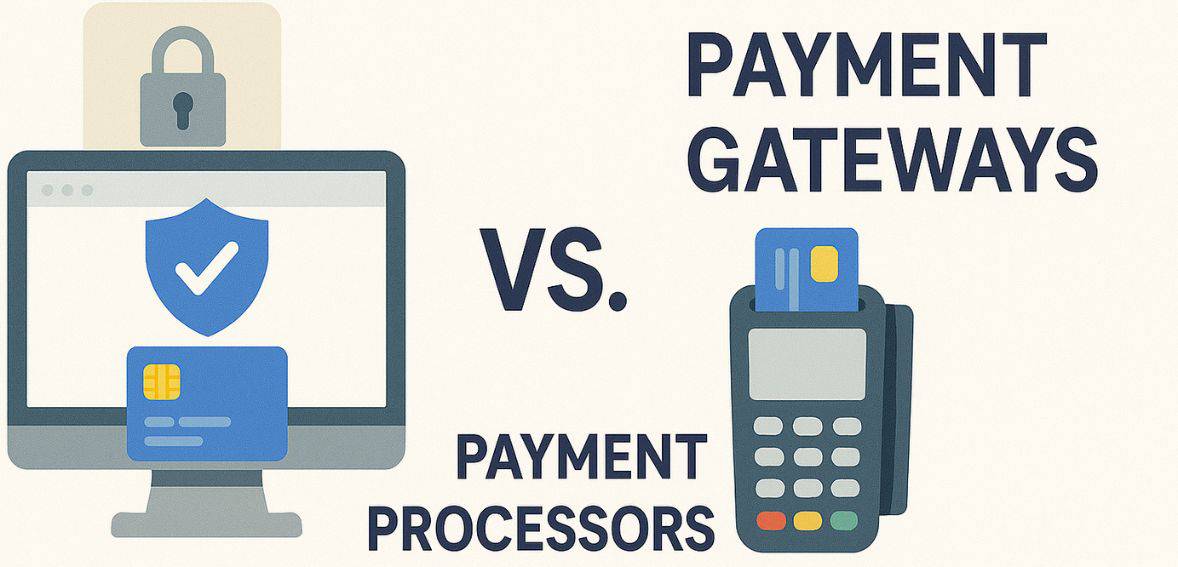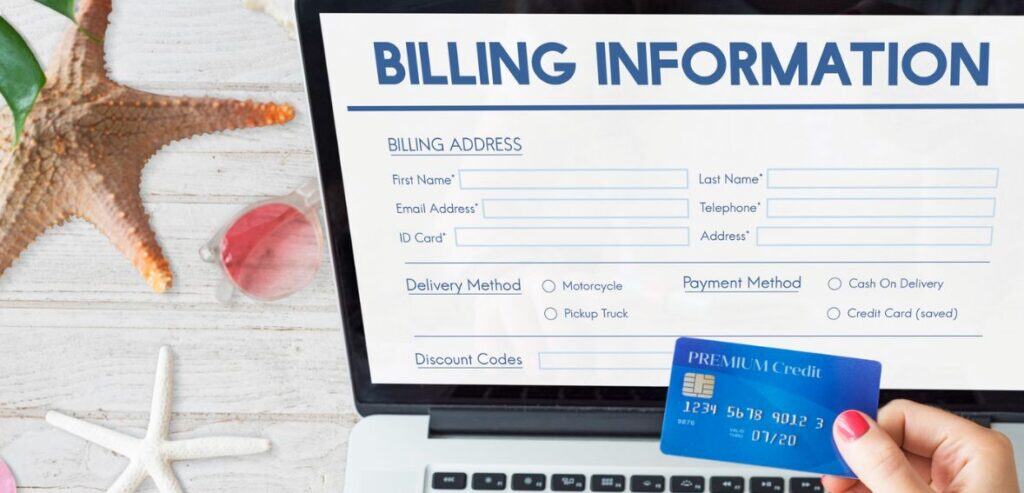
By myhostmerchant.com June 24, 2025
As the digital marketplace continues to evolve, understanding how payments flow behind the scenes isn’t just helpful—it’s essential for running a smooth business. Whether you’re running an online store or a physical retail shop, two systems are at the heart of every customer transaction: the payment gateway and the payment processor.
The efficiency, security, and profitability of your transactions can be directly impacted by understanding the differences between these two entities as eCommerce continues to grow internationally and more companies investigate online payment processing. The variations between these services may seem unclear in 2025 due to technological breakthroughs and rising customer expectations, but their essential purposes are still clear.
The difference between a payment gateway and a processor will be thoroughly explained in this article, along with the workings of payment processing and the factors that merchants should take into account when establishing a successful merchant payment system.
Defining the Roles in Online Payment Infrastructure

Many business owners tend to use the terms payment gateway and payment processor as if they mean the same thing. While both are crucial in making online and in-store transactions happen, they serve very different purposes behind the scenes. A payment gateway is the customer-facing part of the process—the tool that securely collects card information during checkout and encrypts it before passing it along.
Think of it as the virtual equivalent of a point-of-sale terminal, ensuring customer data is safely transmitted and compliant with security standards like PCI DSS. Once the payment details are securely captured by the gateway, the processor steps in to handle what happens next. The payment processor acts as the behind-the-scenes system that communicates between the merchant’s bank, the customer’s bank, and the credit card networks. Its job is to verify the transaction, check for fraud, approve or decline the payment, and make sure the money ends up in the right place.
While the gateway deals with data capture and transmission, the processor focuses on the movement and settlement of funds. Together, these two components form the backbone of electronic payments. The gateway handles the front-end interaction and encryption, while the processor makes the actual transaction happen. Knowing how these systems differ—and how they work together—can help businesses choose better payment solutions, reduce friction at checkout, and ensure a more reliable experience for both the merchant and the customer.
How Payment Processing Works in Practice
The gateway instantly encrypts and transmits the payment information when a customer starts a transaction, whether via a retail point-of-sale terminal or a mobile app. Based on a number of variables, such as account balance, fraud analysis, and card status, the payment processor then gets in touch with the card networks and issuing bank to decide whether to accept or reject the transaction. Following approval, the funds are sent through the processor, passed through Visa and Mastercard card networks, and then deposited into the merchant’s account.
All of this takes place in a matter of seconds, but it requires complex coordination between several different entities. The difference between the payment gateway and the payment processor lies in this transaction journey. The processor is in charge of the transaction’s logistics and execution, even though the gateway serves as the first point of contact and security.
In today’s fast-paced world, especially in 2025, customers expect lightning-fast checkouts and top-notch security. That’s why it matters more than ever to understand who does what in the payment flow.
The Role of API Integration in Modern Payment Infrastructure

These days, APIs are the glue holding modern payment systems together. They help your website, CRM, and payment tools talk to each other behind the scenes. Essentially, an Application Programming Interface (API) enables effective communication between the payment gateway and processor and your accounting software, CRM, website, and other business systems.
The API manages every aspect of this configuration, including tokenization, customer authentication, and real-time transaction status updates. Merchants are able to provide a smooth checkout process while keeping control over the data flow through their platforms through API-driven systems. This results in faster settlements, reduced disruptions, and increased flexibility in managing payment sources or switching providers.
Strong API support may be the difference between disjointed payment systems and a cohesive commerce strategy for companies looking to grow or go omnichannel. In order to minimize customer drop-off and optimize the entire transaction chain, the gateway and processor both rely on secure APIs to exchange payment information in milliseconds.
Mobile Commerce and Its Impact on Gateways vs Processors
Since most online purchases are now made through mobile devices, companies must reevaluate how their payment systems support multi-factor authentication, smaller screens, and quicker transactions. In this situation, the distinction between the gateway and the processor becomes even more crucial.
One-tap checkouts, digital wallet integration, and biometric security protocol compatibility are essential features of a payment gateway designed for mobile payments. On the other hand, processors need to manage these fast-moving transactions while keeping their authorization rates high and their latency low.
This dynamic forces companies to select gateways made for mobile-native user experiences in addition to scalable processors. High cart abandonment rates can arise from a failure to adjust, particularly for customers who anticipate easy payment methods like Apple Pay, Google Pay, or QR codes.
If your customers are mostly on mobile—which most are now—you’ll need to be sure your gateway works well on small screens and your processor can keep up.
Fraud Prevention—Whose Responsibility Is It?
Fraud prevention is one of the more ill-defined aspects of the payment gateway vs. processor debate. The reality is more complex, but many merchants believe that one party will take care of everything. Gateways are usually your first line of defense when it comes to catching fraud. They frequently provide real-time transaction screening tools like AVS (Address Verification System), 3D Secure authentication, and simple rule-based filters.
Before the transaction even gets to the processor, these checks are made. Payment processors intervene with chargeback monitoring, velocity checks, and risk-scoring models after the transaction has been routed. Processors, on the other hand, are more focused on spotting big-picture trends and keeping fraud under control over time.
Therefore, in order to develop a comprehensive fraud defense strategy, businesses need to consider both layers. Relying solely on one side leads to blind spots that can result in increased chargebacks, frozen accounts, or even legal complications. A coordinated effort between your gateway provider and processor is essential for robust risk mitigation.
Subscription Models and Recurring Billing Workflows

A new need in payment processing has been brought about by the growth of SaaS platforms and subscription-based services: smooth recurring billing. According to this model, the gateway manages client consent, safely saves payment information (often through tokenization), and starts repeating transactions without the need for client involvement.
However, the processor needs to minimize declines throughout billing cycles and preserve transaction consistency. Payments can easily fail when a card expires or runs out of funds—which happens a lot with subscriptions.
Businesses require gateways with adaptive billing strategies, card updater features, and intelligent retry logic to address this. In order to improve authorization rates, processors must support recurring billing flags to alert issuing banks. Because the boundaries between gateway and processor duties can become hazy. That’s why it’s smart to work with providers who understand subscription models and have tools built just for them.
Without this base, companies run the risk of losing clients and money as a result of avoidable transaction errors. It is now essential to figure out these payment mechanisms as subscription models spread throughout industries.
Gateway vs Processor 2025: What Businesses Need to Know
As technology advances, choosing a gateway over a processor in 2025 involves more than just function; it also involves integration and strategy. Modern gateways often include processing services or basic processing capabilities. To obtain better prices, negotiate contracts, or access cutting-edge features, enterprise companies and individuals looking for flexibility may choose to work with different providers.
As payments get more complicated, businesses need systems that can grow with them, often by adopting modern payment solutions that enhance efficiency and scalability. Payment processors, meanwhile, are enhancing their capabilities with machine learning, tokenization, and better reconciliation tools.
Their responsibilities go beyond simple money transfers; they also handle compliance, chargeback management, and risk assessment. The right processor can either drive your business forward—or slow you down, especially if you operate in a tough or fast-changing industry.
eCommerce Payment Setup and Strategic Considerations

Selecting the appropriate gateway and processor combination is a fundamental step in developing your online payment processing architecture. Some companies choose an all-in-one provider to make setup easier, but others might need modular configurations because of industry or regional requirements. For example, a multinational eCommerce company that sells in both the US and Europe might require a processor that allows for multi-jurisdiction settlements and a gateway that can localize checkout experiences.
Merchant payment systems have seen substantial innovation in 2025 as a result of competition between gateway and processor providers. Strong payment systems now come standard with features like intelligent retry mechanisms for unsuccessful transactions and dynamic routing, which chooses the best route for transactions to boost approval rates.
Customer support, integration capabilities, uptime, and dependability are important factors in addition to features. Additionally, the expectations around online payment processing have changed as a result of the rise of mobile wallets, open banking, and instant payments.
In addition to providing smooth interoperability with other payment methods, gateways now need to interface with new payment rails. On their part, processors have to handle these new flows quickly and accurately while adhering to ever-changing international regulatory frameworks.
Conclusion: Choosing the Right Payment Architecture
Long-term success depends on knowing the functions and distinctions between payment gateways and payment processors in the increasingly complex world of digital commerce. The processor is the backbone that moves money and makes transaction settlements possible, while the gateway guarantees safe and seamless consumer interactions during checkout.
In 2025, businesses must clearly assess their payment infrastructure requirements and make decisions that support their expansion plans, customer satisfaction objectives, and legal requirements. With the correct approach, businesses can reduce expenses, increase the approval rate of transactions, and provide a payment experience that increases revenue and fosters trust.
Making an informed choice is essential to gaining access to seamless and future-proof merchant payment systems in the gateway vs. processor market of 2025.